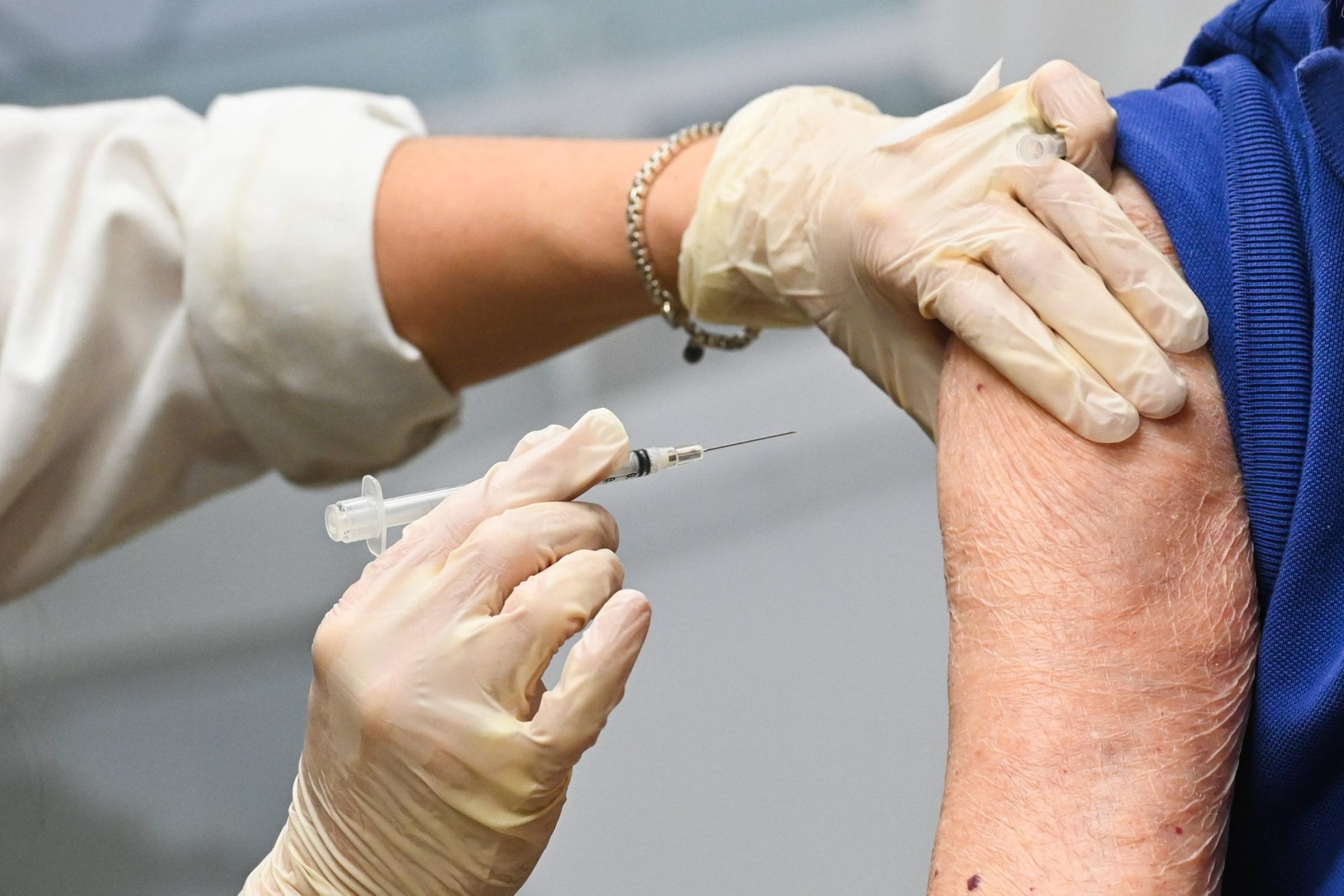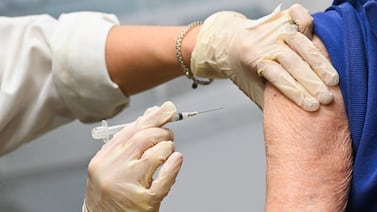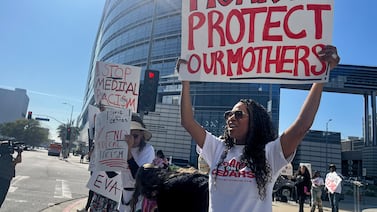Public health, explained: Sign up to receive Healthbeat’s free New York City newsletter here.
As the Covid-19 pandemic spread through New York City in March 2020, researchers affiliated with the City University of New York launched a nationwide research project tracking the disease, its financial and mental health impacts, and eventually, vaccine uptake.
Over time, they became particularly interested in understanding the barriers to Covid-19 vaccination for people with anxiety and depression. That led to a research project funded by about $3 million from the National Institutes of Health, exploring what prevents people with anxiety and depression from getting vaccinated, and testing out possible interventions.
But last month, the project’s grant was terminated, part of a wave of deep cuts to NIH funding that has impacted research institutions throughout New York and the United States. The team of about 15 people working on the project had completed collecting data, but still had significant analysis and writing to do, said Dr. Denis Nash, a distinguished professor of epidemiology at the CUNY School of Public Health and one of the project’s principal investigators, alongside Dr. Angela Parcesepe, an associate professor at the Gillings School of Global Public Health at the University of North Carolina at Chapel Hill.

It was a “devastating” development for research that took root at the start of the pandemic, Nash, who is also the executive director of the CUNY Institute for Implementation Science in Population Health, told Healthbeat.
Last spring, CUNY researchers had recruited about 1,500 people from their CHASING COVID Cohort Study who had received a primary series Covid-19 vaccination but were not up to date on their vaccines. As part of the study, participants were texted or emailed a questionnaire that included a link to one of three videos showing an interaction between a doctor and patient. One video used cognitive behavioral therapy techniques to encourage vaccination, another countered vaccine misinformation, and a third presented standard public health messaging on the benefits of vaccination. Researchers returned to the participants after four weeks and again at six months to record their vaccination status.
In this interview, edited for length and clarity, Nash describes what his team’s research involved, and what it means to have their grant terminated.
Where did this research emerge from?
[The CHASING COVID Cohort Study] measured mental health and depression and anxiety pretty frequently over the course of the four or five years that we followed the cohort. When things started to subside with the pandemic, we were realizing that the next set of problems is: How do we contribute to an understanding of improving vaccination outcomes?
When we started this latest study, maybe 21% of adults around the U.S. had received the latest Covid vaccine, which is not nearly as high as it needs to be. Angela and I decided to do something we hadn’t done with the cohort before, which was to develop some kind of intervention that we could deploy to see if we could improve outcomes. Before that, we were just observing people and gathering information about them. It was useful and important, but we had not tried to see if there were things that we could do to influence their health behaviors and outcomes.
We had another researcher on the team who had done some intervention work around inoculation theory, around misinformation and disinformation. It’s this idea that if you prepare people in advance that they might be exposed to inaccurate information, or deliberately deceptive information, when they are confronted with those messages later on, they’re better prepared to deal with it and not be manipulated by it.
Based on our research, we learned that people with common mental disorders in our cohort were more likely to endorse misinformation and disinformation. In other words, they were more likely to cite that as reasons for not being vaccinated. And they also reported barriers that especially the mental health experts on our team thought could be overcome, with cognitive behavioral therapy-type interventions.
So we designed these three brief videos, and we wanted to see if we randomized people to get one of these three videos, did it have an effect on people’s decision to get vaccinated over the subsequent four weeks? Did it change their likelihood of making an appointment, or deciding to make an appointment, and then actually going to get vaccinated?
What did your research find?
We didn’t, unfortunately, see an impact of the intervention on outcomes. But it was important for us to do the study to assess whether there was a theory-informed low-touch strategy that could be used here. There have been other studies in the literature, for example, where pharmacies would send text outreach reminders to people, and [differences in vaccine uptake] tended to be pretty small, like a 1% increase. That’s in line with what we saw. But we were taking a different approach, in that we were trying to get people to engage in a way of thinking about what might be delaying them or getting in the way of something they want or feel that they need.
Did the research suggest interventions that could work better?
The things that are getting in the way among people who have been vaccinated before, but are not up to date, are bigger than a brief one-minute video could potentially overcome. It doesn’t mean that an approach like this couldn’t work; it may need to be a little more intensive in some ways.
How did you find out your funding was terminated?
I was at an HIV conference in San Francisco at the time, and I heard from a reporter at Science that a reputable source at NIH leaked a list of canceled grants. Mine was on it; did I care to comment?
We had heard in the days before that there were going to be a bunch of vaccine-related grants canceled. We were bracing ourselves, but the messaging was such that everyone whose grant was canceled had been told the night before. So part of me was thinking, maybe we dodged a bullet. But the fact was, they hadn’t told everyone yet. A few hours after that interaction with the reporter, we got the official notice from NIH.
It was devastating. It was a horrible time. The feeling at this conference was kind of like a funeral. I was running into so many people with cancelled grants. The Columbia cancellations had just happened, and my colleagues from Columbia were there. It was a horrible week.
Where does this leave your research?
The devastating thing is that we still had a lot of analysis and writing to do, and it was all abruptly halted when the grant was canceled. So we have the paper with the four-week outcomes that was already submitted to a journal. We are busily revising that, but there are many other papers that we want to write to contribute to this knowledge, that we’re not going to be able to do, or it’s going to happen way more slowly.
We have faculty and staff, and many of the staff are PhD and master’s students that we pay to work on these research projects, and they learn how to do research in the process. [Now] they’re not allowed to work on it because we don’t have funding to support it. They can volunteer their time to do that, but that’s not the same as paying someone 40 hours a week to do data cleaning, to help us do literature searches, and analyze data in support of preparing a manuscript. It’s really a team effort. Without paid staff, it’s going to move much more slowly.
What did it mean for you to have NIH supporting this research?
We launched the [CHASING COVID Cohort] of our own accord, with very limited institutional funds, but we thought it was important to start. At the same time, we wrote a grant to NIH to support it going forward, including the blood specimens we needed to collect from all participants over time. And we did get emergency funds from NIH to do the cohort.
So the investment in this work goes way back, to March of 2020, on the part of NIH. If you want to think about efficiency, in this particular grant, they paid for all the data collection. And participants have volunteered their time and contributions to the work, only to have the most important part — the contributions to knowledge, to science, to the field — be abruptly curtailed. It is a huge loss, and definitely not part of the mission of NIH and [the U.S. Department of Health and Human Services]. They’re all about trying to contribute to scientific knowledge and improving public health outcomes. It’s a very untimely termination.
Eliza Fawcett is a reporter covering public health in New York City for Healthbeat. Contact Eliza at efawcett@healthbeat.org.






